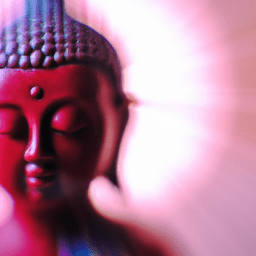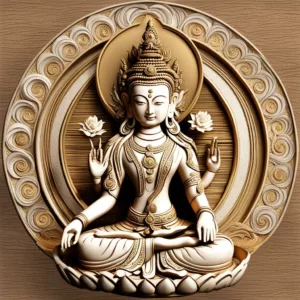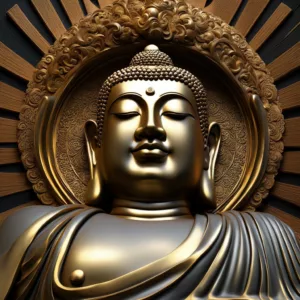The four karmas are the four Buddha activities: pacifying, enriching, magnetizing, and destroying (or subjugating). They are siddhis undertaken spontaneously by advanced yogic practitioners and enlightened beings for the sake of benefiting others and bringing them along the path to liberation.
Table of Contents
4 Karmas / Buddha Activities of Tantric Buddhism
| English | Sanskrit | Meaning | Wisdom |
|---|---|---|---|
| Pacifying | säntvayema | Seeing without Judgment | Mirror-like Wisdom |
| Enriching | arthakarana | increasing material and spiritual resources. Providing self-worth to others. | Equanimity Wisdom |
| Magnetizing | saṃgraha | Attracting needed resources for dharma. Attracting students. | Discriminating Wisdom |
| Destroying/ Subjugating | Vaśyā | Overcoming Obstacles and negative forces. | All-Accomplishing Wisdom |
What are the 4 karmas in brief

The four karmas are Buddha activities to overcome samsara. They are pacifying, enriching, magnetizing and destroying.
Karma means activity. The four karmas are the enlightened methods, basically purified forms of ordinary activities. They’re means to help bring beings to liberation, to work with the kleshas – negative emotions that beings experience, the karmic obscurations, cognitive obscurations and obstacles that beings experience and that blocks them from the cessation of suffering and from finding peace.
The four karmas are associated with the four directions and the five primordial Buddhas and wisdom energies. The karmas are typically engaged in a specific, are in some sense engaged in a specific order and in terms of skill they come that way. Many people engage someone instinctively in pacifying energy.
Pacifying intro
The karma of pacifying, as it sounds, is to keep a situation, is to calm a situation. Pacifying is associated with the East, the Eastern energy and the mirror-like wisdom of Akshobya, of the primordial Buddha Akshobya.
It’s just calming a situation down in a certain extent, but from an enlightened perspective it’s generally seeing a situation with crystal clarity, reflecting just being there and reflecting the reality of the situation back at the participants. This can help soothe subtle neuroses and habitual patterns and cliche activity.
When some negative energies arise it’s allowed to simply subside without reacting to them. The energy has nothing to amplify it. Like ripples in a pond that reach the edge, they simply die out and disappear. Pacifying tends to be associated with the purification of anger and the associated color is blue.
The southern energy of Ratnasambhava is associated with enriching and the wisdom of equanimity. It’s a purified pride which becomes equanimity.
Enriching intro
All the karmas can have many aspects, but one of the primary aspects of enriching is seeing the inherent goodness and wealth of virtue in other beings. Essentially seeing them as the Buddha capable, potentially capable of manifesting all the infinite Buddha qualities with a treasure trove of compassion, wisdom, generosity, and the other paramitas and the limitless virtues of the Buddha. From the enriching perspective, one sees all beings with that as capable, as imbued with the Buddha nature, in fact as fully enlightened Buddhas.
Magnetizing Intro
The first two karmas are generally considered very safe. It’s, someone can practice with them and try and make efforts to do pacifying and do enriching. The latter two karmas are considered more dangerous.
Magnetizing is the third one. The color is red. It’s associated with Amitayus in the West. Amitayus is also considered the Buddha of eternal life and the Buddha of boundless light. The energy is discriminating awareness.
We’re seeing the qualities of all things. The magnetizing energy is essentially bringing forth the virtues of the Buddha in oneself to a powerful and profound extent such that other people find one attractive. People want to be around you and receive teachings from you.
Manifesting compassion, generosity, skillful means, wisdom, and so forth, people are drawn to the energy of the person who skillfully manifests magnetizing. The risk here is probably fairly obvious and that one can become magnetizing in an ego driven way, wanting to be that person. Instead of it becoming a natural egoless magnetizing, it’s actually for the benefit of others. It becomes a sense of making oneself seem a great yogi or bodhisattva or whatever.
Magnetizing comes from desire and it’s more neurotic manifestations. It can be what’s called a very Padma energy, almost a sleazy sexualized energy.
Destroying Intro
The fourth karma of destroying is considered the most dangerous. Generally, people are urged not to seriously practice destroying. It’s also called subduing or accomplishing. It’s associated with the all-accomplishing wisdom of Amogasiddhi in the north and the color is green. Destroying in the north is associated with the negative emotion of jealousy.
Destroying is typically spoken of as wrathful energy which appears as anger which is not angry but arisen out of compassion. The pitfalls should be quite obvious and could fool themselves into thinking they’re acting wrathfully when they really just have ordinary anger.
Their anger is in control of them but they pretend it’s wrathfulness and they let their emotions run free. Obviously the same issues arise with magnetizing but destroying energy can be practiced at a more basic or more simple level in terms of accomplishing.



4 Karmas Illustrated
For example, if you put together a plan to build a house that is the pacifying phase. Purchasing materials and the site would be enriching, along with increasing knowledge. Magnetizing would be hiring workers and starting work. Destroying is actually doing the job.
The four karmas arise naturally from the situation when it relates to an enlightened being. The enlightened energy will spontaneouldy manifest what is appropriate for the situation. The four karmas are a purified form of ordinary activities. They’re the enlightened activities of the Buddha which always exists only for the benefit of beings.
If someone practices incorrectly the karmas become negative. It’s important to practice them appropriately within the context of deity meditation so that the skill is developed correctly. Otherwise it simply becomes another manifestation of ego.
Ground of the 4 Karmas
The four karmas are what Siddhas (realized beings) do spontaneously. They feel out a situation and simply act in accordance with the situation along the lines of one of these four activities. The four activities are practiced in most inner sadhana practices. The practitioner would supplicate for them as siddhi, the siddhi of the four karmas, and the yidam would grant the siddhi.
The standard preparations obviously require taking refuge and bodhisattva vows, developing an understanding of emptiness, and to truly practice the 4 karmas, a clear direct perception of emptiness is critical.
However, people on the lesser paths, like myself, can practice them to some extent, even in real life. It’s suggested to practice primarily with the pacifying and somewhat with enriching, because these are the safe karmas. Magnetizing is somewhat more risk-prone while destroying or subjugating has a lot of pitfalls and can create dangers.
One of the keys to the four karmas is they can’t be strategized on a situation-by-situation basis. It doesn’t work like that. If a person is in such a psychological state, for example, how can I pacify them? On the other hand, it is good to contemplate situations afterward and think of what the best response would have been in terms of the four karmas and in terms of how to apply whichever one made the most sense.
How to meditate like a yogi
and enter profound samadhi
The Karma of Pacifying

The energy of pacifying comes from the east. In a sense, pacifying is simply the external application of the mirror-like wisdom of clear seeing. Seeing things correctly, the yogi of pacifying perceives the situation and doesn’t need to do anything but merely be present.
Compassionate awareness radiated into a situation can clear up obstacles for the other people. It might simply be just a kind word when someone’s upset over something or someone really wants something badly that they can’t have, just a slight distraction into something more important. This folds into the spontaneous, free-flowing application of pacifying.
In my opinion, from what I’ve seen, the siddhis of each separate karma can be developed separately. Generally, it’s considered a sequence. In other words, don’t jump straight to destroying. Don’t jump straight to destroying. Try pacifying then enriching, then magnetizing, then destroying.
This is obviously an intermediate and not a highly skilled approach. The great practitioner, the siddha, would immediately see what needs to be done and either instantaneously apply any steps up to the necessary one or skip steps, bypass them altogether. It could also be said that each of the first karmas is automatically included in the later karmas.

Flow, the profound mental state, also called Peak Performance, can be attained with meditation and can be ‘triggered’ at will, with enough discipline. Guide to Flow Mastery will teach you how.
Ground, Path, and Fruition of the 4 karmas
Ground means what is. Path means the methods practiced to realize the Ground. Fruition is the realization.
The karmas can also be analyzed in terms of their ground path and fruition link or in terms of breaking them down into the four karmas of the four karmas, the pacifying of pacifying, the enriching of pacifying, and so forth. For now, we’ll take the approach of the ground path and fruition.
The ground is the same no matter which you choose because it is choosing or determining how to approach the situation, feeling the situation out and wondering which karma to apply. The ground is basically seeing what is the situation that we find ourself in. In a sense, this ground is merely the application of pacifying.
Pacifying is seeing the situation clearly, but there’s a little more to the path of pacifying which is to share that, not verbally, but in a sense, to be able to understand, and projecting to everyone involved in the situation a sense that the situation is seen clearly, that the things people don’t want to say are understood, they’re known by someone. And importantly, they are not judged, simply seen.
The little attempts to slightly hide or slightly duck away or misrepresent at a subtle level that we all do are not accomplishing their purpose. And moreover, a very important next step is being unbiased. These sorts of habitual approaches are just the way people go about things. We don’t criticize people for being unenlightened because that’s our lot too.
We simply see clearly and let be, highlighting the neurosis so that everyone can see it without judgment at some level and the way it’s being engaged in can be released. It doesn’t have to be held on to.
The fruition, the outcome or result is ideally the neurotic tendencies are released, they are understood or seen clearly. A significant or meaningful opening arises, a sense of not believing in the neurosis, or the neurotic tendencies.



Secrets of Meditation for Anxiety
Like millions of people, you may have suffered from anxiety for years. Meditation, yoga, peaceful music – it never works. It takes too long, and it’s not stable. Why? Because peace is treated as a cause for freedom, but it’s not – it’s the result. The cause to free yourself from anxiety is completely different.
Click now to Overcome Anxiety for good.
Part II: Enriching & Magnetizing

May all beings be happy
May all beings be peaceful
May all beings be safe
May all beings awaken to the light of their true nature
May all beings be free







